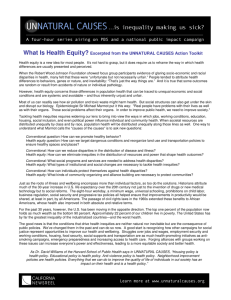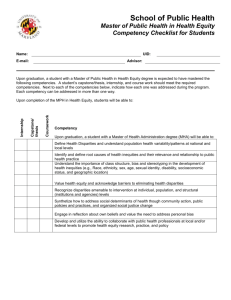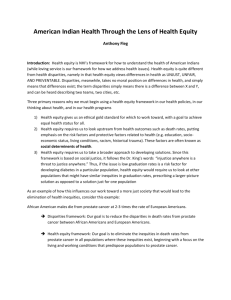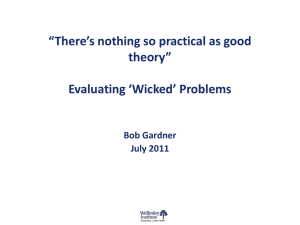New Haven Health Equity Alliance 9/25/09 Startup Work Session Meeting
advertisement
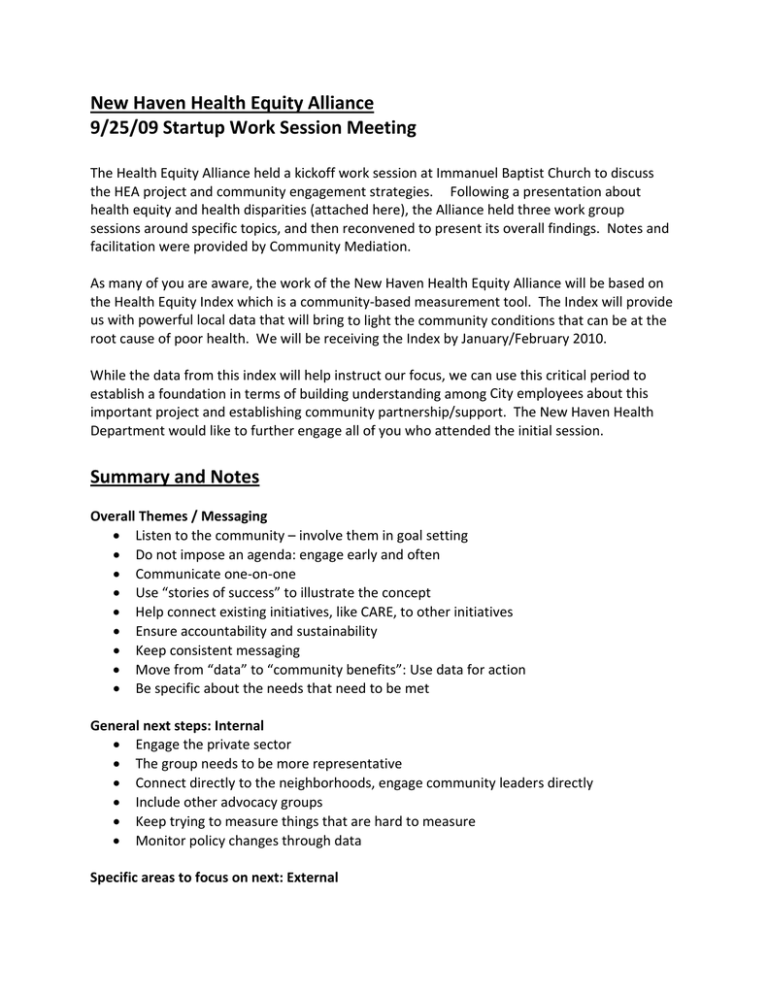
New Haven Health Equity Alliance 9/25/09 Startup Work Session Meeting The Health Equity Alliance held a kickoff work session at Immanuel Baptist Church to discuss the HEA project and community engagement strategies. Following a presentation about health equity and health disparities (attached here), the Alliance held three work group sessions around specific topics, and then reconvened to present its overall findings. Notes and facilitation were provided by Community Mediation. As many of you are aware, the work of the New Haven Health Equity Alliance will be based on the Health Equity Index which is a community‐based measurement tool. The Index will provide us with powerful local data that will bring to light the community conditions that can be at the root cause of poor health. We will be receiving the Index by January/February 2010. While the data from this index will help instruct our focus, we can use this critical period to establish a foundation in terms of building understanding among City employees about this important project and establishing community partnership/support. The New Haven Health Department would like to further engage all of you who attended the initial session. Summary and Notes Overall Themes / Messaging Listen to the community – involve them in goal setting Do not impose an agenda: engage early and often Communicate one‐on‐one Use “stories of success” to illustrate the concept Help connect existing initiatives, like CARE, to other initiatives Ensure accountability and sustainability Keep consistent messaging Move from “data” to “community benefits”: Use data for action Be specific about the needs that need to be met General next steps: Internal Engage the private sector The group needs to be more representative Connect directly to the neighborhoods, engage community leaders directly Include other advocacy groups Keep trying to measure things that are hard to measure Monitor policy changes through data Specific areas to focus on next: External Take actions now – don’t spend years just talking Pick a few things and do them well: Have short‐term and long‐term goals/changes Change neighborhood schools Connect work to early childhood care Transportation and land use “Health impact assessments” when city projects are completed Breakout Session Notes Workshop 1: How do we most effectively engage the community? 1. What are the best ways to engage the Community? (To a lesser extent: What will work most effectively to engage community members from across the city to encourage or promote efforts that will address health inequities?) Engage residents early on (and often) – Starting right now Ask community members/leaders: “What works best for you?” Choose a convenient time for residents to come to meetings: after work, weekends, etc. STORY: how to tell stories that matter, transform, inspire, bring people to a higher place Watching the video by Color of Words was effective Engaging with Ownership (help people feel a sense of ownership in the process) Relationship Building: get people to care about each other, invest in each other’s lives Having a Vision (ex. “Vision Zero”) – Help create a vision for community health State clearly what values you have Partner with groups already doing this work Empowering Youth (in schools, etc.) Connect what we want to do with groups that already exist: community gardens/greenspaces, small grants recipients, arts groups – make connections with their projects Engage people where they are Identify those who we might not already know about (as leaders) – get out and find out who are doing things to advance their communities. Be honest and transparent about our expectations – Act with integrity Be careful of jargon – Talk to people in ‘real’ terms Share Knowledge: Visibility & Collaboration as values 2. How do we become a Community/Engage the Unengaged? Let people see you where they are Talk with (not to) people – LISTEN to what they say Build a relational culture: “We’re in this together” Have tangible resources in our community to support people Look at Dr. Felton Earl’s work: Decreasing violence by engaging the community Also, see the example of the Chatham Square Food Bank (no agencies involved) Also engage people who are willing to volunteer – Time Banks? Engage Leaders who don’t come into our view/don’t come to meetings Include people directly related to this work (not just the directors, but those who are working on these issues on the ground level) Workforce Development presentation to staff/community organizers “Cut across Silos” – Agencies/Groups working together Solve ‘whole person’ issues Question: Do we have true “buy‐in” from everyone here at the table? Instead of “Outreach”, “Be with” people Have dialogues among service providers and community members 3. How can we use the Health Equity Index (HEI) and other striking data most effectively to motivate action? The Health Equity Alliance will be improving this process in the next few months… Ask: “How are people going to be better off?” Using the HEI in a process leading to better legislation – Keep the City/Government involved It’s about changing the structure of society (changing individual behavior is a part of that) Look at CARE: Following the lead of the community – Their staff asked to be added to the agenda at upcoming community meetings, rather than ask for a special session or demand that they be added to the current agenda. Help residents organize their own meetings Workshop 2: What actions are needed to address social and health inequities? What actions are necessary? Look more broadly at primary preventions – make resources to parents of newborns available so they don’t use the emergency room; give parents what they need to have youth ready for kindergarten Garner local political support – mayor, police dept., etc. Reach out to organizations/people at the State level – i.e. legislators Create tax incentives for closing the gap – using public transportation, stocking healthy foods in your store, etc. Create improved public transportation More time‐efficient Usability More hours User‐friendly routes Survey who could be using and target them with marketing More synergy – Yale buses, hospital shuttles, city buses Change land‐use policy Break down silos Sidewalk repairs Make sure all city departments thinking about health when creating plans Promote policy initiatives to address issues like obesity, diabetes, cancer, etc. Support programs already happening, like discounted fresh fruits/vegetables for senior citizens Do more outreach Create uniformity of messages among health care providers Public service announcements Get beyond this room Make data readily available to all and make the date uniform – city has some stats, BOE has some stats, State has some stats – none are the same Get tools out to the neighborhoods Who should be involved? Businesses Public Schools Hospitals/health care centers – Provider community Media Local & State government – Mayor, Governor, Legislators DCF DSS Dept. of Public Health Dept. of Transportation Neighborhoods Funders Leaders How do we create synergy? Involve neighborhood leaders Food policy council working with NH Public Schools Older adults working with youth – i.e. walk together to school Start with what is already happening and build on that as well as finding what is missing Advice for HEA More info flowing between organizations – more coordination Keep social determinants as a focus All sectors & neighborhoods involved Marketing/media included – prioritize message and keep consistent among various sources Select 2 or 3 major policy initiatives that are cost‐effective and feasible/realistic Return to neighborhood schools/take buses off street – cost‐saving (cut 10%, save $1.4 million) and exercise Include institutions/organizations who are usually out of the loop – i.e. private schools Give more concrete things to people who need them Clarify how this is different Pain in the side of those in power – make sure they follow through Implement the actions – don’t just talk Focus on some instant successes to build momentum Don’t expect public schools to do all the work Engage key stakeholders at the state and local level – even if it is just to inform them Clear definition of goals and pick 2‐3 to work on Workshop 3: Design Principles: How can we ensure the success of this initiative? How to produce change: More involvement from the healthcare department which would include funding as well as policy changes. Clearly set short term as well as long term goals Information collected should be shared quickly, in a comprehensive manner, among the different organizations involved. Results Based Accountability (RBA): comparing before and after results, and/or based on logic model. Assuring sustainability of the programs Constant communication Establish a link between the communities targeted and the efforts that are being done. Process for evaluation Establish what the expectations of the community are. Collect data that is locally specific and track the sentiment of the community as far as the success of the efforts made. Necessary partners Community residents, Identify the representatives of the community Measures of success Getting positive results in one community may translate into other communities getting interested in that result and being willing to implement the same changes. Focus on groups that are interested Chain reaction: for example, educating parents who are illiterate will automatically make them more able to make their children interested in reading books. It will be important to measure the collaborative efforts between the different associations and individuals concerned. Shed a good light on any success, not just the ultimate successes sought. It is important to link the different players needed to get results, such as healthcare, transportation and education. Evaluate the data collected. Bring stories of success to communities. Advice gathered from the participants to the breakout session: Establish an ongoing communication system about shorterm/longterm goals The community should be involved in setting those goals in order to enhance its sense of involvement. This should be a communitywide effort, involving municipal players as well as grassroots organizations Identify all participants and follow up with them on a regular basis. Ask ourselves how inequities should be measured Monitor the occurrence of policy changes and encourage them, for example in areas like housing since the link between bad housing conditions and asthma has been established. Policy changes don’t only involve government nor need to await government, for example businesses, education departments and Yale could implement some of these policy changes. Decision making process: determine who is going to be involved. Get more funding by attracting money through established and well articulated successes. New Haven Health Equity Alliance September 25, 2009 1 GETTING TO THE ROOT: THE CT HEALTH EQUITY INITIATIVE Bill Quinn Director, New Haven Health Department Elaine O’Keefe El i O’K f Office of Community Health, Yale School of Public Health Health Disparities defined as differences in the incidence and prevalence of health conditions and health status between groups Persistent disparities in health status of CT and New Haven residents are well documented and indisputable Disparities occur by race, ethnicity, gender, g g education, income level, geographic area, sexual orientation, disability, or combination of factors Greatest health disparities within CT and New Haven occur between racial and ethnic population groups Health disparities are not random events They can be traced, directly or indirectly to ffundamental inequities in social, economic status, d l l and to racial inequality The cumulative effects of racism result in lower education and economic status for the majority of CT’s Black and Hispanic residents Racial and ethnic SES inequities contribute to racial and ethnic health disparities People of color are significantly more likely , g to die as infants, have higher rates of chronic disease and disability, and have p shorter life spans BACK TO BASICS: SOCIAL AND ECONOMIC UNDERPINNINGS OF HEALTH Health inequities = Disparities that result from systemic, Disparities that result from systemic avoidable and unjust distribution of the conditions and resources that support good health, which are beyond the control of individuals BACK TO BASICS: SOCIAL AND ECONOMIC UNDERPINNINGS OF HEALTH S i l d Social determinants of health = i f h l h Life‐enhancing resources whose distribution across populations effectively determines length and quality of life: Food supply Housing Economic and social relationships Transportation Education Health care Health Equity = Fairness in the distribution of the resources that support healthy outcomes for all people Research underscores imperative to shift focus to h d i i hif f underlying causes Significant body of research documents that social inequalities and SES are principal causes of q p p morbidity and mortality Research shows that adverse social, economic and environmental conditions are major determinants of poor health status Genetics 10‐15% Access to health care 10‐15% 15% + 15% = only 30% WHAT CAUSES THE OTHER 70%??? PERSONAL RISK BEHAVIORS??? Paradigm Shifting: From Medical to Ecological Model Medical Model GENETICS Socio-Ecological UPSTREAM SOCIAL FACTORS Class R Race/ethnicity / th i it Gender Immigration Status INSTITUTIONAL POWER Corporations C ti & other businesses Gov’t agencies Schools NEIGHBORHOOD CONDITIONS Environment E i t Social Physical Residential Segregation RISK FACTORS/ BEHAVIORS DISEASE & INJURY Infectious disease Chronic disease Injury (intentional & unintentional) Smoking Nutrition Physical activity Violence Chronic St Stress HEALTH H CARE ACCESS A SOCIAL INEQUALTIES DOWNSTREAM HEALTH STATUS MORTALITY Infant mortality Life expectancy -Source: Bay Area Regional Health Inequities Initiative Paradigm Shifting: From Medical to Ecological Model Medical Model GENETICS Socio-Ecological UPSTREAM Health Inequities SOCIAL INEQUALTIES Class R Race/ethnicity / th i it Gender Immigration Status INSTITUTIONAL POWER Corporations C ti & other businesses Gov’t agencies Schools NEIGHBORHOOD CONDITIONS Environment E i t Social Physical Residential Segregation Health Disparities RISK FACTORS/ BEHAVIORS DISEASE & INJURY Infectious disease Chronic disease Injury (intentional & unintentional) Smoking Nutrition Physical activity Violence Chronic St Stress HEALTH H CARE ACCESS A SOCIAL FACTORS DOWNSTREAM HEALTH STATUS MORTALITY Infant mortality Life expectancy -Source: Bay Area Regional Health Inequities Initiative Goal 1: Increase Quality and G l I Q lit d Years of f Healthy Life Help individuals of all ages increase life expectancy and improve their quality of life. G l Eli i Goal 2: Eliminate H l h Di Health Disparities ii Eliminate health disparities among segments of the population including differences that occur by population, including differences that occur by gender, race or ethnicity, education or income, disability, geographic location, or sexual orientation. Improve income and reduce wealth inequities I i d d l h i ii Improve physical and built environment Promote racial justice j Promote better working conditions Improve conditions for children Improve social inclusion Improve education Improve food security and quality I Improve public and sustainable transportation bli d t i bl t t ti Health Impact Assessments Universal Health Care Unnatural Causes Policy Guide All Policy is Health Policy y y Social policy is health policy p y p y Economic policy is health policy Ed ti li i h lth li Education policy is health policy ‐ David Williams A tool to help communities identify and A t l t h l iti id tif d change the conditions that bring about health inequities Built on social determinants of health Uses local demographics and health g p outcomes Community Context i Health Equity Index NHHD Workforce Development Community Engagement 18 Identifies, quantifies and measures the Id ifi ifi d h social determinants that lead to health di disparities ii Set of Nine Social Determinants S t f Ni S i l D t i t Economic Security & Financial Resources Livelihood Security & Employment Opportunity School Readiness & Educational Attainment Environmental Quality Civic Involvement & Political Access Availability & Utilization of Quality Health Care Adeq ate Affordable & Safe Ho sing Adequate, Affordable & Safe Housing Community Safety & Security Transportation p Example of Index Components Economic Security/ Financial Resources Income Median Household Income US Census/ Claritas Wealth/ / Assets •Media Value- Owner Occupied Homes •Land/Building Assessed Value •Sales Prices •Average A # off Vehicles V hi l •US Census/Claritas •Local Tax Assessor Poverty % Households Below Poverty % Individuals with Income <50% Poverty % Children <18 in Poverty C Concentration i off Poverty US Census/ C / Claritas Public Assistance Rate per Household •TFA •Food stamps •SAGA Department of Social Services Access to Capital •Approval Rates- Home Purchase Mortgages •# of Home Purchase Mortgages g g Home Mortgage Disclosure Act q y Health Equity Index Health Equity Alliance Continuous Planning & Quality Improvement Cycle Q li I C l Action Plans Strategies to Address Health Inequities New Haven Health Department Workforce Development – – Health Dept and other City staff C Community Health i H l h providers and agency staff Community Engagement and Collaboration: – – – – City Departments Health Providers Community Agencies Grassroots Recalibrate Strategies Data / Evaluation 22 Year One • • Build strong new partnerships supported by an engaged, trained Health Department staff. Engage the New Haven community in understanding and using the Health Equity Index findings, framework, and related information to improve our health and quality of life. Year Two • • Develop a Community Action Plan to reduce health inequities in New Haven grounded in the HEI Framework. Institutionalize the project processes and use of HEI and related data in local policy and planning processes. 24 New Resources Federal, local and university partners National Movement to Address Health Equity New Approach Needed Increasing recognition of the power of social determinants 25 • • • • • • • • Health Health – Provide health equity framework, training and leadership; data Board of Education – Health essential to achievement ‐‐ School Wellness Plan with community partners, healthier food, and better coordination of in‐ school health and student support services pp Economic Development/City Plan – Job creation, job retention and the built environment are critical to improving health status Parks/Public Works – Promote physical activity through improved, accessible facilities and recreation programs Transportation – move from traffic management to Sustainable & Equitable Transportation, with “complete streets” legislation. Y th S i Engage many partners to address serious youth risk factors Youth Services ‐‐ E t t dd i th i k f t and build “protective factors” to reduce youth delinquency and violence Police – Safe neighborhoods, strategies for engagement Finance – reduce health benefit costs through workplace wellness campaign 26 g g g p y Engaging Multiple Community Collaboratives New Haven Early Childhood Council City‐Wide Youth Coalition School District Wellness Plan CitySeed Ex‐offender Reentry Roundtable New Haven Safe Streets Coalition & Complete Streets Legislation Community Alliance for Research and Engagement (Yale) Public and foundation resources to engage community around diet, physical activity and tobacco Yale Griffin Prevention Research Center Yale‐Griffin Prevention Research Center Grant renewed for 5 years People in the audience know of many more examples! 27 Responsibilities Analyze and document inequities in neighborhoods Collect and present information in ways that influence policymakers, empowers the community and engages the li k h i d h media Promote City interdepartmental and larger community y p g y discussions Create data driven, culturally competent, transparent to the community evidence‐based interventions that address the community, evidence‐based interventions that address the needs and ideas from the community engagement process Create a community climate of greater individual, i i i institutional, and community accountability l d i bili 28 • Consolidate baseline data and reporting C lid b li d d i • Connect citywide projects and policy initiatives • Build relationships and awareness of Health Equity within neighborhoods and among community leaders; organize for action • Develop a full Community Action Plan by 2011 29 30
